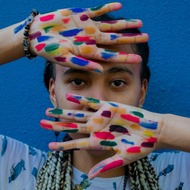
(View Complete Item Description)
This unit is presented as a progression of tasks that allow students to explore movement through a variety of creative tasks. Students will move in personal and general space, while exploring elements of shape, size, speed, force, flow, and time. To promote student confidence and willingness in dance, teachers should isolate the dance elements before asking students to apply these elements using imagery or partner/group tasks.The National Standards and Grade-Level Outcomes in this unit are referenced from the "National Standards & Grade Level Outcomes for K-12 Physical Education."SHAPE America Outcomes:KindergartenPerforms locomotor skills in response to teacher-led creative dance. (S1.E5.K)Maintains momentary stillness on different bases of support. (S1.E7.Ka)Forms wide, narrow, curled and twisted body shapes. (S1.E7.Kb)Contrasts the actions of curling and stretching. (S1.E10.K)Travels in general space with different speeds. (S2.E3.K)Recognizes that when you move fast, your heart beats faster and you breathe faster.3 (S3.E3.K)Follows directions in group settings (e.g., safe behaviors, following rules, taking turns). (S4.E1.K)Identifies physical activities that are enjoyable. (S5.E3.Ka)Grade OneCombines locomotor and nonlocomotor skills in a teacher- designed dance. (S1.E5.1)Maintains stillness on different bases of support with different body shapes. (S1.E7.1)Demonstrates twisting, curling, bending and stretching actions. (S1.E10.1)Differentiates between fast and slow speeds. (S2.E3.1a)Differentiates between strong and light force. (S2.E3.1b)Identifies the heart as a muscle that grows stronger with exercise, play and physical activity. (S3.E3.1)Accepts personal responsibility by using equipment and space appropriately. (S4.E1.1)Describes positive feelings that result from participating in physical activities. (S5.E3.1a)Grade TwoPerforms a teacher- and/or student- designed rhythmic activity with correct response to simple rhythms. (S1.E5.2)Balances on different bases of support, combining levels and shapes. (S1.E7.2a)Differentiates among twisting, curling, bending and stretching actions. (S1.E10.2)Combines balances and transfers into athree-part sequence (i.e., dance, gymnastics). (S1.E11.2)Varies time and force with gradual increases and decreases. (S2.E3.2)Identifies physical activities that contribute to fitness. (S3.E3.2b)Practices skills with minimal teacher prompting. (S4.E1.2)Identifies physical activities that provide self-expression (e.g. dance, gymnastics routines, practice tasks in games environments). (S5.E3.2)Photo Attribution: KCBalletMedia (Photography: Brett Pruitt & East Market Studios)References:Graham, G., Holt/Hale, S. A., & Parker, M. (2013). Children moving: A reflective approach to teaching physical education. 9th ed. New York: McGraw-Hill.Joyce, M. (1994). First steps in teaching creative dance to children. California: Mayfield Publishing.
Material Type:
Lesson Plan
Author:
Dorann Avey




















